ABSTRACT
A journal’s citation rate is an indicator of its quality. The presented study builds on analyses of the citation rate of the VTEI journal published in previous years. A new analysis of VTEI journal citations using Web of Science data was conducted and the citation analysis using Scopus data was updated. A comparison of citations in both bibliometric databases was performed to determine the degree of overlap between the two databases and whether it is more appropriate to monitor the citation rate in one or both bibliometric databases. The citation analysis confirmed a high degree of overlap between the two databases. For monitoring the citation rate of the VTEI journal, it is sufficient to track citations in the Scopus database; unique citations found in the Web of Science database represent only a small portion of all citations. The citation analysis also confirmed the increasing trend in the number of citations of articles published in the VTEI journal, which was noted in previous years.
INTRODUCTION
The VTEI journal readers may already be used to citation overviews of the VTEI journal over recent years [1–3] based on Elsevier’s Scopus citation database. As stated by Teixeira da Silva [4], one could argue that no bibliometric analysis is complete without using the “titans” of bibliometric databases [5], i.e. the Scopus and Web of Science databases. Therefore, this year, the summary of VTEI journal citations is done in the form of a comparison of the citations in these two main bibliometric databases, despite the fact that these databases cannot be considered a global overview of scientific knowledge [6] and, for example, Google Scholar provides much greater coverage [7, 8].
The Web of Science and Scopus databases were chosen by the Government Research, Development and Innovation Council (R&D&I Council) as source databases for bibliometric assessments in the M2 module according to the so-called Methodology 17+ [9]. A number of studies in the past have shown that the two databases overlap considerably [10, 11]. Since the use of two paid databases for bibliometric studies is relatively expensive, even the R&D&I Council refrains from using both databases in parallel and uses Scopus for the evaluation of humanities, with Web of Science for the evaluation of other fields.1
The aim of this study is to assess both databases from the point of view of the journal publisher, which is not indexed in any of the mentioned databases. The main research question that this study tries to answer is whether it is sufficient to monitor the journal citation in one of these databases, or whether it is more appropriate to monitor it in both bibliometric databases and combine the results.
DATA AND METHODOLOGY
Data collection was carried out in several steps on 7–11th February 2024; consequently, the data was continuously updated until 2nd March 2024. First, data
from both databases was collected and stored in a spreadsheet. The results from both databases were then compared and if a citation from one database was missing from the other, the source file and source database were checked. In this way, several citations that were not found during the initial search were added to each database.
The procedure described in the 2022 citation analysis [2] was used to collect data from the Scopus database using the following search query:
REF (“technicko-ekonomick* inf*”) OR REF (“Vodohosp* techn*”) OR REF (“Wat* manag* tech* econ* inf*”) OR REF (“Wat* manag* tech* and econ* inf*”)
OR REF (vtei) OR REF (“Vodoh* Tech.-Ekon* Inf*”) OR REF (10.46555/vtei)
Using this query, 181 records were found, of which only 153 cite the VTEI journal. After analysing the Web of Science data, the search query was expanded to:
REF (“technicko-ekonomick* inf*”) OR REF (“Vodohosp* techn*”) OR REF (“Wat* manag* tech* econ* inf*”) OR REF (“Wat* manag* tech* and econ* inf*”)
OR REF (vtei) OR REF (“Vodoh* Tech.-Ekon* Inf*”) OR REF (10.46555/vtei) OR EID (2-s2.0-84908355749) OR EID (2-s2.0-85160256067) OR EID (2-s2.0-85021403793)
OR EID (2-s2.0-14844301688) OR EID (2-s2.0-27544497058)
On 2nd March 2024, the query returned 191 results in the Scopus database. Of these, only 163 cite the VTEI journal.
A procedure based on the search of cited documents was used to collect data from the Web of Science database. In the Web of Science web interface, the following query was made to all databases on the Cited References tab:
10.46555/VTEI.* (Cited DOI) or VODOHOSPOD* TEC* (Cited Work) or VTEI (Cited Work) By analysing the results found, the search query was gradually enlarged to:
10.46555/VTEI.* (Cited Work) or VODOHOSP* TEC* (Cited Work) or Wat* Manag* Tech* Econ* Inf* (Cited Work) or Journal of Vodohosp* (Cited Work)
or Vodohosp* tech-nicko-ekonom* inf* (Cited Work) or VTEI Vodohosp* (Cited Work) or TECH* EKON* INF* (Cited Work) or Vodn* hosp* VTEI (Cited Work) or Vodoh* Tech*-ekon* Inf* (Cited Work) or VTEI* (Cited Work)
This query returned 123 cited references, which were cited by 122 papers indexed in the Web of Science database. Similar to the Scopus database, all citations were manually checked to ensure they actually cite the VTEI journal, and only one citation was discarded due to an incorrect VTEI citation record. After analysing the Scopus database, the query was complemented to:
10.46555/VTEI.* (Cited DOI) or VODOHOSPOD* TECH* (Cited Work) or VTEI* (Cited Work) or Water Manag* Tech* Econ* Inf* (Cited Work) or Journal of Vodohosp*
(Cited Work) or Vodohosp* tech-nicko-ekonomicke inf* (Cited Work) or VTEI Vodohosp* (Cited Work) or Vodni hospodarstvi VTEI (Cited Work) or TECHN EKONOM INFORM (Cited Work) or Vodoh. Tech.-ekon. Inf. (Cited Work)
The resulting query offered 126 cited references, which were cited by 124 works indexed in Web of Science. Eight additional citations were manually added that were found in the Scopus database but were not retrieved by the search query in Web of Science, although manual inspection found these citing papers. On 3rd February 2024, the query was applied for the last time. One of the issues with the Web of Science database is that the query returned different numbers of results on different days.
The query results were exported to a spreadsheet and the same citing and cited articles were linked in it. A key consisting of information on the year of publication of the citing article, the DOI of the citing article, and the identifier of the cited article was created to link the citing articles. The DOI for articles assigned to it, or a combination of year of publication, volume, issue, and page range, was used as the identifier of a cited article. Citing articles that failed to be matched automatically were checked manually in both databases in two steps. In the first step, articles were searched using their title, and in the second step, they were searched according to the source (journal) and the year in which they were published. Thanks to this pairwise linking, several overlooked citations were found and added to the list.
RESULTS AND DISCUSSION
In total, 163 citing articles were found in the Scopus database, which cited the VTEI journal 227 times, and 133 citing articles were found in the Web of Science database, which cited the VTEI journal 179 times. Fig. 1 shows the number of citing articles in 2009–2023; Fig. 2 shows the number of citations in the same period. Citations before 2009 are very sporadic in both databases. There is no point in displaying the data for the year 2024 as the analysis is carried out at the beginning of the year and the data for the year 2024 is not yet complete. The graphs confirm that the course of citations in both databases has a similar development. They also demonstrate that the higher number
of citations in the Scopus database is a matter of the last five years. For the sake of completeness, it is appropriate to add that in the period before 2009 the number of citations and citing articles in both databases was similar.
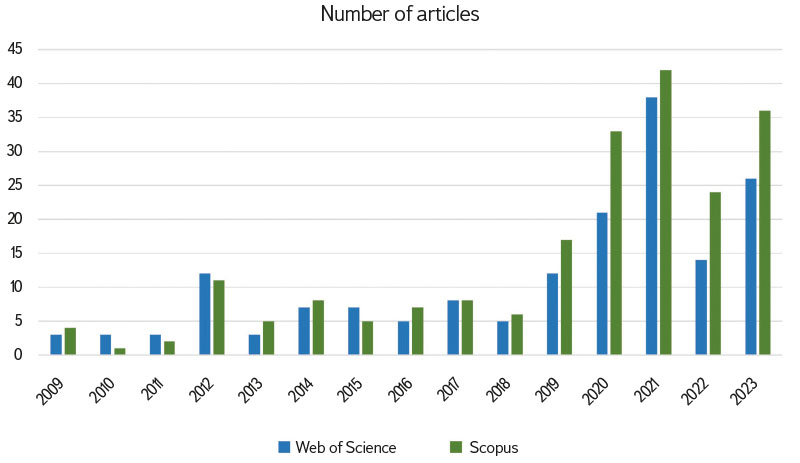
Fig. 1. Number of articles in the Web of Science and Scopus databases that cite the VTEI journal
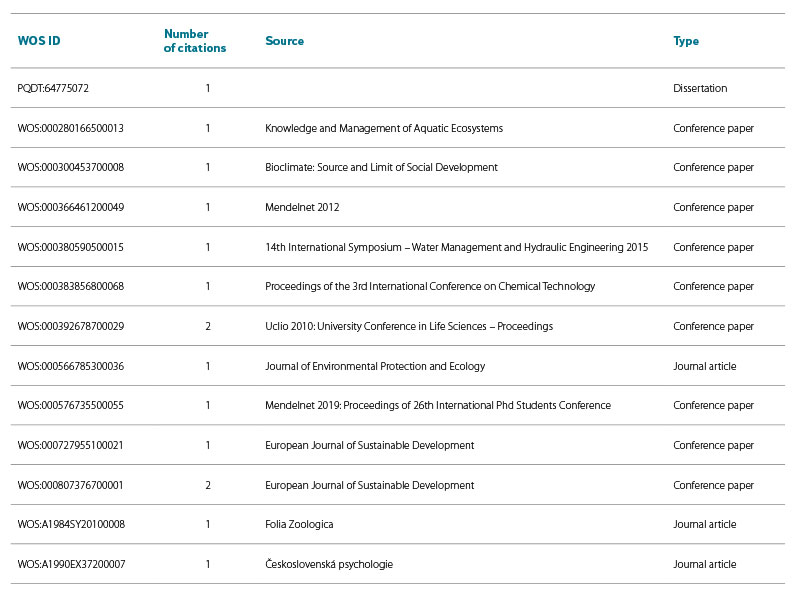
Fig. 2. Number of citations of VTEI journal indexed in Web of Science and Scopus databases
The overlay of both databases is shown in Tab. 1. In the Scopus database, one article [12] was found under two EIDs (2-s2.0-72149085715 and 2-s2.0-84898078896). In reality, 162 articles recorded in the Scopus database cite the VTEI journal a total of 225 times.
The total number of unique citations is therefore 240, of which 93.75 % is covered by the Scopus database and 74.6 % by the Web of Science database. If only the Scopus database were monitored, the 15 unique citations in Web of Science make up 6.7 % of the citations found in the Scopus database. In contrast, if only the Web of Science database were monitored, the 61 unique citations in the Scopus database make up 34.9 % of the citations in the Web of Science. There is thus a relatively simple answer to the main research question, i.e. whether it is possible to monitor citations in only one database, or whether it is necessary to monitor citations in both databases: simply monitor
the citations in the Scopus database.
Tab. 1. Number of citations of the VTEI journal in the Scopus and Web of Science databases
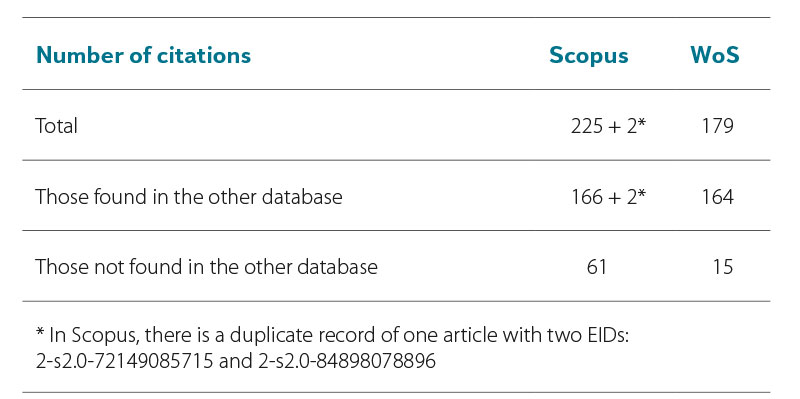
The second part of the analysis focused on sources of unique citations in individual bibliometric databases. There are 15 unique citations in the Web of Science database. A summary of them is presented in Tab. 2. Of the 13 papers that cited VTEI papers 15 times, there is one dissertation, two journal articles, and 10 conference papers. However, some conference papers were published in special issues of scientific journals.
Tab. 2. Summary of citing articles unique to WoS

The situation with articles in scientific journals is interesting. The Knowledge and Management of Aquatic Ecosystems journal is indexed in the Scopus database, but the article [13] that cites the VTEI journal is not indexed. There is a similar case of an article in Journal of Environmental Protection and Ecology [14] – the journal is also indexed in the Scopus database, but in this case, the Scopus database is missing practically an entire issue in which this article was published. The article in the Folia Zoologica journal [15] is indexed in the Scopus database with EID 2-s2.0-0021579833, but no information about the references is provided. Another example is the European Journal of Sustainable
Development, which was briefly indexed in the Scopus database in 2020 and 2021 (this journal has been continuously indexed in the Web of Science database since 2013); however, the articles citing VTEI were published in issues that are not indexed in the Scopus database. There is a similar situation in an article in the Československá psychologie journal [16] from 1990, while this year was not yet indexed in the Scopus database. It is worth mentioning here that this article cites “VTEI” but is probably not a citation of the VTEI journal. Unfortunately, the data in Web of Science is very incomplete, so it is impossible to make a clear deduction.
A summary of unique citations in Web of Science originating from scientific journals again shows a large overlap in both databases. For publishers seeking indexing in one of these prestigious databases, it is advisable to continuously monitor both databases, as it may happen that some articles are not recordedor indexed correctly by the respective database. In such a case, it is possible to report erroneous or missing citations by using the correction mechanisms that the operators of both databases offer.
Sources of unique citations in the Scopus database are listed in Tab. 3. As Fig. 3 shows, the largest share of 61 unique citations in the Scopus database is made up of citations from Czech journals (16 citations). A total of 13 (9 + 4) citations come from conference papers that were published in proceedings or proceedings journals. They thus form the second largest group of citations. The third largest group is represented by citations from books (7 citations). Slovak journals (5 citations) are in a shared fourth place, which is probably due to the language similarities and historical ties of the Czech and Slovak scientific communities. The same number, i.e. 5 citations, was also achieved from Polish journals. This can be attributed to the relatively large representation of Polish journals in the Scopus database (in the field of Environmental Science, there are a total of 45 journals in the Scopus database, according to SCImago data; 16 are Czech and only 6 are Slovak).
Tab. 3. Summary of sources of unique citations in Scopus
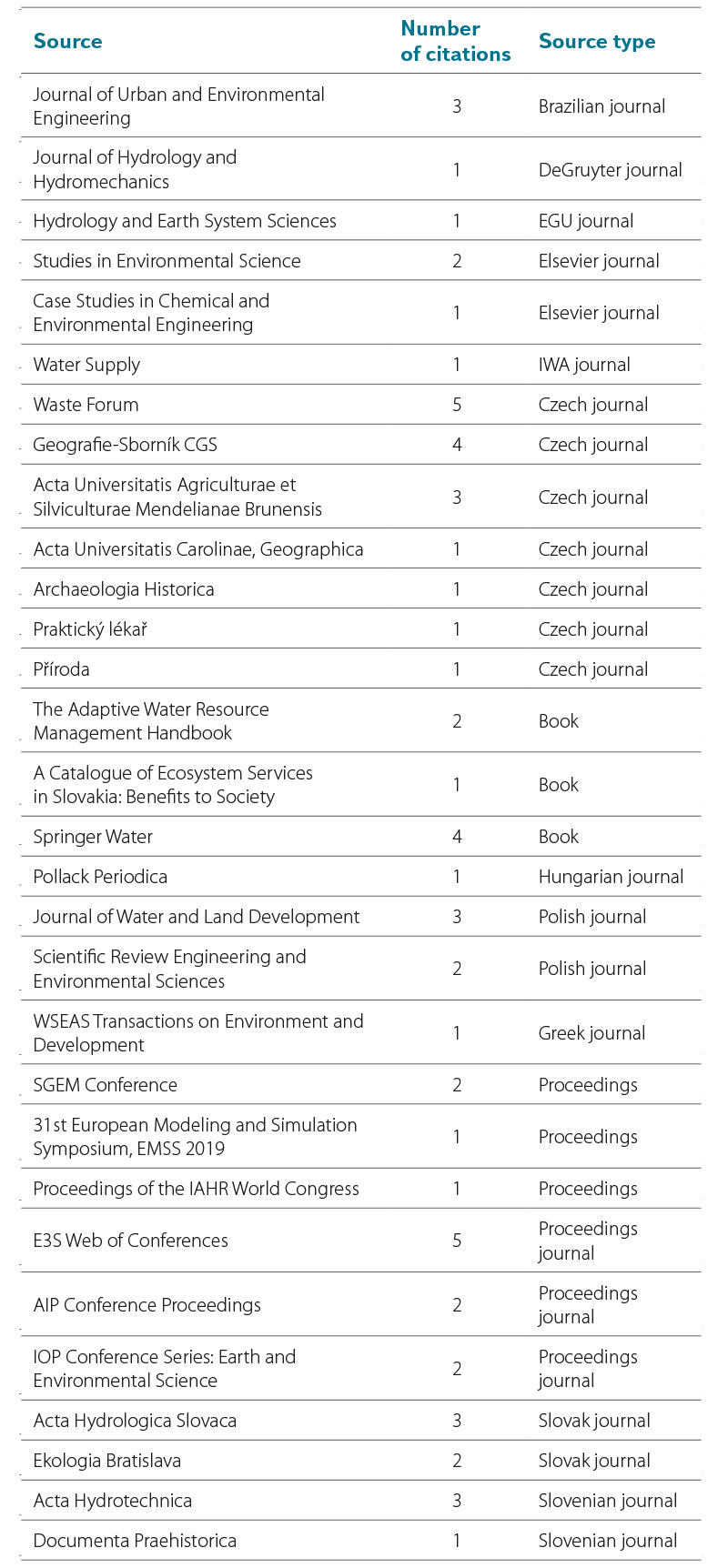
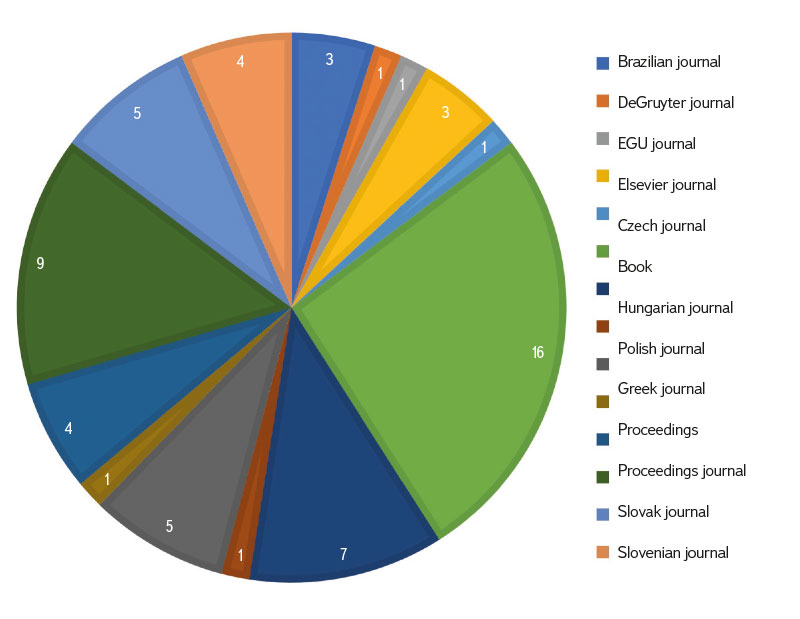
Fig. 3. Unique sources of citations in Scopus by type of source
Errors and uncertainties in the analysis
Several errors were found when comparing the two bibliometric databases. In Web of Science, there is an obvious error in importing data on cited articles for five records. Two records (WOS:000537175800007 and WOS:000391291500003) had incomplete VTEI citation data imported, and two records (WOS:000363210700001 and WOS:000323402700035) did not have VTEI citation data imported at all. For the entry WOS:A1990EX37200007 [16], it cannot be clearly decided whether the VTEI journal was cited or not. For Scopus record EID 2-s2.0-85145674435, or BCI:BCI202300160752 in WoS, different data on the number of citations are given. While there are 45 references in the Scopus database, three of which cite an article in VTEI, there are only 24 references in Web of Science, and only one of them refers to an article published in VTEI.
In total, three articles published at the turn of 2023 and 2024 (2-s2.0-85183954325, 2-s2.0-85183058560 and 2-s2.0-85185194161) were found in the Scopus database which are not yet indexed in Web of Science; however, in the future, they will be included there, as they are published in journals indexed by the Web of Science database. Similarly, there may also be an increase in the number of citations for 2023 due to citations in proceedings and books.
The main issue of using these databases for citation studies of regional journals is the exclusivity of both bibliometric databases, which only index selected journals and choose the indexed journals based on their own criteria. These indexing databases represent a certain standard of quality for a number of academics, which is also proven by the use of these databases by the R&D&I Council
as a data source for bibliometric analyses according to Methodology 17+ [9]. In bibliometrics, a number of researchers have confirmed the so-called “Matthew effect” [17], where articles published in journals included in “prestigious” databases tend to receive a higher number of citations than articles in other journals.
Nevertheless, the increasing number of VTEI citations in both databases over the past five years can be considered as some evidence of the increasing quality of the VTEI journal. On the other hand, it is also necessary to consider the fact of the gradually expanding scope of both databases covering more and more journals every year, which will undoubtedly bring with it an increase in the number of citations in non-indexed journals. Another possible explanation is the increasing number of cited works in individual articles.
This phenomenon is documented by several studies and referred to as “citation inflation” [18]. A deeper analysis of the influences explaining the increase in the number of VTEI citations in the Web of Science and Scopus databases was not the subject of this study and will perhaps be the goal of some future bibliometric studies focused on the VTEI journal.
CONCLUSION
The citation analysis showed that the VTEI journal citation rate in articles that are indexed in the Web of Science or Scopus databases is stable and the number of citations is on the rise. Both databases recorded a higher number of citations than in 2022, although lower than in the most successful year so far, 2021. In terms of citations, 2023 thus became the second most successful year in the history of the VTEI journal.
The higher number of citations in the Scopus database can be attributed to the different focus of the two databases; Scopus covers a larger spectrum of journals, while Web of Science focuses more on the “core” of academic journals. Scopus thus indexes a larger number of regional journals. However, the overlap between the two databases is large and it can be said that it is not necessary for the journal publisher to monitor both databases; with accepting some inaccuracy, it is sufficient to monitor the citations in the Scopus database.
Note
1. Although on the R&D&I Council website (https://m17.rvvi.cz/m2/calculation-procedure-and-output-design/) (04/03/2024) we can read that additional analyses from the Scopus database are performed for selected field groups 2 Engineering and Technology, 4 Agricultural and Veterinary Sciences, 5 Social Sciences, and 6 Humanities and The Arts, the data on inclusion in quartiles according to the Scopus database for 2017–2021 contained only group 6, while the data for 2016–2020 contained all four groups.
This article was translated on basis of Czech original by Environmental Translation Ltd.
Conflict of interest statement
The author is part of the TGM WRI management, which publishes the VTEI journal, and the chairman of the Editorial Board of the VTEI journal. However, these facts had no influence on the results of the presented study. TGM WRI did not provide any funds for the preparation of this study.
Data availability statement
All data used in the study can be obtained from the Web of Science and Scopus databases using the procedures described in this study. On request from the author, it is possible to obtain the source file in MS Excel format, in which all analyses were performed.
